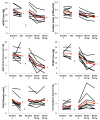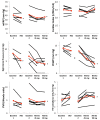Acute hemodynamic effects of inhaled sodium nitrite in pulmonary hypertension associated with heart failure with preserved ejection fraction
- PMID: 27812547
- PMCID: PMC5085611
- DOI: 10.1172/jci.insight.89620
Acute hemodynamic effects of inhaled sodium nitrite in pulmonary hypertension associated with heart failure with preserved ejection fraction
Abstract
Background: Pulmonary hypertension (PH) is associated with poor outcomes, yet specific treatments only exist for a small subset of patients. The most common form of PH is that associated with left heart disease (Group 2), for which there is no approved therapy. Nitrite has shown efficacy in preclinical animal models of Group 1 and 2 PH, as well as in patients with left heart failure with preserved ejection fraction (HFpEF). We evaluated the safety and efficacy of a potentially novel inhaled formulation of nitrite in PH-HFpEF patients as compared with Group 1 and 3 PH.
Methods: Cardiopulmonary hemodynamics were recorded after acute administration of inhaled nitrite at 2 doses, 45 and 90 mg. Safety endpoints included change in systemic blood pressure and methemoglobin levels. Responses were also compared with those administered inhaled nitric oxide.
Results: Thirty-six patients were enrolled (10 PH-HFpEF, 20 Group 1 pulmonary arterial hypertension patients on background PH-specific therapy, and 6 Group 3 PH). Drug administration was well tolerated. Nitrite inhalation significantly lowered pulmonary, right atrial, and pulmonary capillary wedge pressures, most pronounced in patients with PH-HFpEF. There was a modest decrease in cardiac output and systemic blood pressure. Pulmonary vascular resistance decreased only in Group 3 PH patients. There was substantial increase in pulmonary artery compliance, most pronounced in patients with PH-HFpEF.
Conclusions: Inhaled nitrite is safe in PH patients and may be efficacious in PH-HFpEF and Group 3 PH primarily via improvements in left and right ventricular filling pressures and pulmonary artery compliance. The lack of change in pulmonary vascular resistance likely may limit efficacy for Group 1 patients.
Trial registration: ClinicalTrials.gov NCT01431313 FUNDING. This work was supported in part by the NIH grants P01HL103455 (to MAS and MTG), R01HL098032 (to MTG), and R01HL096973 (to MTG), and Mast Therapeutics, Inc.
Conflict of interest statement
M.A. Simon has received consultancy fees from United Therapeutics and Gilead. E.L. Parsley is an employee of Mast Therapeutics, Inc. M.T. Gladwin is a coinventor of awarded patent (number 9,387,224) for nitrite therapy for cardiovascular indications. M.T. Gladwin receives sponsored research support for the inhaled nitrite clinical trial (note: M.T.G. does not receive consulting fees from Mast Therapeutics).
Figures






References
-
- Vachiéry JL, et al. Pulmonary hypertension due to left heart diseases. J Am Coll Cardiol. 2013;62(25 Suppl):D100–D108. - PubMed
Publication types
MeSH terms
Substances
Associated data
Grants and funding
LinkOut - more resources
Full Text Sources
Other Literature Sources
Medical

